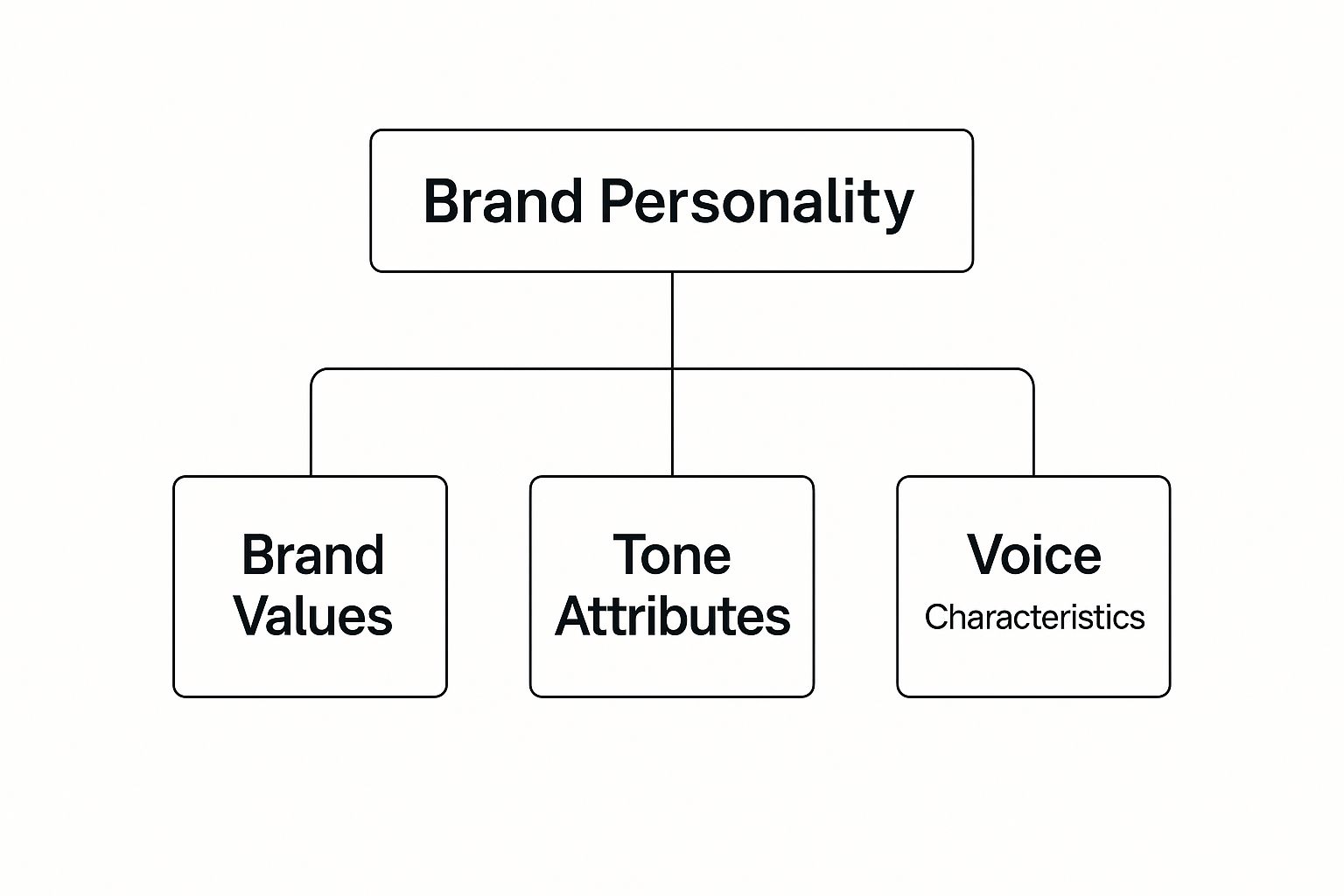Your brand voice guidelines are basically the official playbook for your brand's personality. Think of them as the compass that keeps every email, social media post, and webpage sounding consistently like you.
What Exactly Is a Brand Voice and Why Should You Care?

Think about your favorite brand for a second. What pops into your head? It’s probably more than just a logo or a product—it’s a feeling. That feeling is carefully built through a personality that’s always recognizable, and that’s exactly what brand voice guidelines are for. They're the documented, official version of your brand's unique communication style.
A great way to think about it is to imagine your brand as a person. How does this person talk? Are they witty and a little irreverent, like a clever friend? Or are they formal and authoritative, like a trusted mentor? Your brand voice captures that specific essence, making sure that whether a customer is reading a blog post or chatting with a support agent, the experience feels seamless and familiar.
The Real-World Value of a Consistent Voice
Without a defined voice, your messaging can get messy and confusing. One marketing campaign might sound playful and fun, while your website copy comes across as stiff and corporate. That kind of inconsistency chips away at trust and makes it really hard for people to form a genuine connection with your brand.
In today's crowded market, a distinctive voice is a massive advantage. It cuts right through the noise and helps you build a memorable identity that clicks with your target audience. This is where brand voice guidelines stop being a "nice-to-have" and become a critical business asset.
They are the bedrock for building:
- Customer Trust: When your brand sounds reliable and predictable, you build a powerful sense of trust with your audience.
- Brand Recognition: Just like you can pick a friend's voice out of a crowd, customers learn to instantly recognize your brand's voice, no matter where they encounter it.
- Lasting Loyalty: People form connections with personalities, not faceless companies. When customers connect with your brand's personality, they're far more likely to stick around and become loyal advocates.
A consistent brand voice isn't just about sounding the same everywhere. It's about building a predictable and trustworthy relationship with your audience, turning casual buyers into die-hard fans.
The numbers back this up, too. Brands that nail consistency can see their revenue jump by up to 23%. But here's the kicker: fewer than 10% of companies actually achieve a high level of voice consistency. This leaves a huge opportunity on the table for any brand willing to put in the work.
To give you a quick cheat sheet, here are the core elements you'll be defining.
Core Components of Brand Voice at a Glance
| Component | Description | Example |
|---|---|---|
| Character/Persona | The human-like personality of your brand. | The Sage: wise, guiding, and authoritative. |
| Tone | The emotional inflection used in different contexts. | Empathetic on a support page, enthusiastic in a launch announcement. |
| Language & Vocabulary | The specific words and phrases you use (and avoid). | Using "folks" instead of "users"; avoiding corporate jargon. |
| Cadence & Rhythm | The pace and flow of your sentences. | Short, punchy sentences for social media; longer, detailed ones for blog posts. |
| Grammar & Mechanics | The specific rules you follow (e.g., Oxford comma, headline case). | Always using the Oxford comma; using sentence case for all subheadings. |
Ultimately, defining your voice is a foundational piece of your entire brand identity. If you're just starting out, it’s essential to understand how to build a brand strategy where voice isn't an afterthought—it’s a central pillar that shapes how customers see you and drives your long-term success.
Defining the Four Dimensions of Your Brand Voice
To build brand voice guidelines that actually work, you have to get more specific than just a general "vibe." A truly effective voice isn't just one thing; it's a blend of four distinct, measurable dimensions.
Think of it like a recipe. You need the right mix of ingredients to get a consistent result every time. By breaking your voice down into these four parts—Character, Tone, Language, and Purpose—you create a practical toolkit anyone on your team can use to communicate in a way that’s always on-brand.
Let's dig into each one.
Uncovering Your Brand Character
First up is Character. This is the core personality of your brand—the "who" behind the words. It’s the steady, unchanging soul of your company, kind of like a person's fundamental nature. Is your brand the wise mentor? The quirky innovator? The dependable best friend?
Nailing this down provides the foundation for every single message you send. A great starting point is to think in terms of familiar archetypes.
- The Mentor: Guides, teaches, and empowers with wisdom. (Think of a financial advisory firm.)
- The Innovator: Pushes boundaries, challenges the status quo, and speaks with an eye on the future. (Like a cutting-edge tech company.)
- The Jester: Uses humor and wit to connect with people in a playful, lighthearted way. (A snack brand targeting a younger crowd comes to mind.)
- The Caregiver: Expresses warmth, empathy, and a deep sense of support. (A perfect fit for a healthcare provider.)
Picking an archetype gives you a solid personality to build from, making sure your character stays stable and recognizable no matter where you show up.
Mastering Your Brand Tone
If Character is who you are, Tone is how your character shows up in different situations. It’s the emotional inflection you use depending on the context. You wouldn't talk about a fun new product launch in the same way you’d address a customer’s serious problem, right?
Your voice is your personality, which is constant. Your tone is your mood, which changes depending on the situation and the audience. A strong brand masters both.
Let’s say your brand character is a "Helpful Expert." Your tone would naturally shift:
- On a blog post: Informative, clear, and encouraging.
- In a social media celebration: Enthusiastic, upbeat, and engaging.
- Responding to a support ticket: Empathetic, patient, and reassuring.
Tone gives you the flexibility you need to connect with people authentically across all your channels without ever losing that core personality.
Choosing Your Language and Vocabulary
Now we get into the nitty-gritty. The Language dimension is all about the specific words, phrases, and sentence structures you use—and just as importantly, those you avoid. This is where you make your voice tangible.
For example, do you lean on industry jargon to signal expertise, or do you stick to simple, everyday words to be more accessible?
Get specific about these details:
- Vocabulary: Do you call them "customers," "users," "clients," or "community"? Do you use contractions (like "you're") to sound more conversational, or do you keep things formal?
- Sentence Structure: Are your sentences short and punchy, creating a fast, energetic rhythm? Or are they longer and more descriptive, setting a more thoughtful pace?
- Grammar and Mechanics: Will you use the Oxford comma? What are your rules for capitalizing headlines?
These little choices might seem minor, but they add up to create a distinct communication style that makes your brand instantly recognizable.
Aligning with Your Purpose
Finally, Purpose is what ties everything back to your brand’s mission—your fundamental "why." Every single piece of content should have a clear goal that supports your company's values. This ensures your voice isn't just consistent, but also meaningful and strategic.
This infographic shows how your core personality is the starting point for both your voice and your tone.

As you can see, your brand personality dictates everything else. Before you hit publish, just ask, "Does this message support our mission?" That simple question turns your brand voice guidelines from a style exercise into a powerful tool for building a purpose-driven brand.
A Step-by-Step Guide to Crafting Your Guidelines
Building your official brand voice guidelines can feel like a huge undertaking, but it’s less about inventing a personality from scratch and more about capturing the one that’s already there. Think of it as writing your company's biography.
This process will help you transform that personality into a practical, easy-to-use document that empowers everyone—from marketing to customer service—to communicate with one clear, consistent voice.
Start with a Content Audit
Before you can figure out where you’re going, you need to know where you are right now. A content audit is your first move. It’s all about uncovering the voice you’re currently using, even if you didn’t do it on purpose.
Start by gathering a wide range of your existing content. You want the full picture, so pull examples from every channel.
- Marketing Materials: Grab your best-performing blog posts, landing pages, and email newsletters.
- Social Media: Look at your posts on your most active platforms, whether that’s Instagram, LinkedIn, or X (formerly Twitter).
- Customer Communications: Don't forget support emails, chatbot scripts, or even sales call transcripts if you can get them.
Get your team together and review everything. Ask questions like: "If our brand walked into a room, who would it be?" or "What words immediately come to mind when you read this?" You'll definitely spot some inconsistencies, but you’ll also start to see threads of a voice that just feels right.
Align Your Voice with Your Core Identity
Your brand voice can't just be a cool persona you put on; it has to be real. It needs to be a direct reflection of your company's mission, your values, and the people you're trying to reach. An authentic voice feels genuine because it comes from the heart of your brand.
Go back to your foundational documents. Your mission statement and core values are your North Star here. If your mission is to "simplify complex technology for small businesses," a stuffy, jargon-filled voice is going to create a major disconnect. A clear, helpful, and straightforward voice, on the other hand, would be a perfect match.
Then, get real about your audience. Who are you actually talking to? What keeps them up at night? What are their goals? A voice that connects with tech-savvy Gen Z founders will sound totally different from one targeting established executives. When you sound like your audience, you build trust and make them feel seen.
Use a "This, Not That" Chart to Define Traits
Words like "friendly" or "professional" are squishy. They can mean a dozen different things to a dozen different people. To make your guidelines truly useful, you need to get specific. This is where a "We Are This, Not That" chart becomes your best friend.
This simple exercise forces you to draw a line in the sand, turning vague ideas into clear, actionable direction. By defining what you aren't, you get rid of all the guesswork for your team.
Here’s a great example of what this looks like in practice.

A chart like this sets clear boundaries, making it way easier for a writer or social media manager to nail the right tone every time. For a deeper dive, our guide on how to create brand guidelines offers more frameworks for documenting your brand's full identity.
Document Do's and Don'ts for Key Channels
While your core personality stays the same, your tone will naturally shift depending on where you're talking. A good set of guidelines will offer specific advice for adapting the voice across different platforms. This keeps you consistent while still being smart about the context of each channel.
Break it down for your most important touchpoints.
- Social Media: Get specific about the tone for each platform. Your LinkedIn voice might be professional and insightful, while your Instagram presence could be more visual and playful.
- Blog Posts: Lay out the rules for structure, headline style, and storytelling. Do you prefer an active voice? Are your posts how-to guides, big-picture thought pieces, or something else entirely?
- Email Marketing: Differentiate between your salesy emails, your regular newsletters, and the automated transactional messages. Define how to write a subject line and what a call-to-action should sound like.
- Customer Support: This one is huge. Provide clear guidance on being empathetic, patient, and helpful. Include some go-to phrases for handling common problems.
Your brand voice guidelines should be a living document, not a dusty PDF. It's a practical tool designed for daily use, helping everyone speak with one, unified voice that builds brand equity with every word.
By getting into these channel-specific details, you create a resource people will actually use. For an even more detailed walkthrough, check out this an ultimate brand voice guide that digs into building trust and engaging your audience. It'll help ensure your guidelines are both thorough and easy to follow, making consistency a real, achievable goal for your whole team.
Learning from Brands Who Get It Right
Okay, let's move from theory to practice. Frameworks are great, but seeing brand voice in the wild is where the lightbulb really goes on. We're going to break down the voices of three brands you know instantly, just by how they sound.
By looking at how Nike, Slack, and Starbucks handle their Character, Tone, Language, and Purpose, you'll see exactly how a clear voice becomes a massive advantage. These guys don't just sell stuff; they pull you into their world. Their secret? A voice that’s real, consistent, and a perfect match for who they are.
Nike: The Empowering Motivator
Nike's voice is inspiration. It’s that inner coach pushing you to find one more ounce of strength. They aren't just selling you shoes; they're selling you the belief that you can hit your personal best.
This voice is built on a few core ideas:
- Character: The Champion. Nike’s persona is confident, laser-focused, and obsessed with greatness. It talks to the athlete living inside every one of us.
- Language: It's powerful and direct. They use short, punchy phrases that get your blood pumping. Think "Just Do It." It's all about action.
- Purpose: Simple and huge—to empower human potential. From a Super Bowl ad to a single tweet, every word is meant to help you break through your limits.
Nike’s voice doesn’t just describe products; it creates a tribe of motivated people who feel like part of a movement.
Slack: The Helpful Collaborator
Slack took the headache out of workplace communication by making a seriously complex tool feel simple, human, and honestly, a little bit fun. Its voice is a masterclass in being helpful without being annoying.
The character here is that super-efficient, friendly coworker who knows where everything is and is happy to help, but doesn't hover over your shoulder. It’s supportive, but respects your time. That’s a tricky balance to strike, and it’s all thanks to their voice guidelines.
Slack’s voice is built on empathy. It anticipates what you need and speaks in a way that’s clear, concise, and never talks down to you.
They use simple, everyday language and deliberately steer clear of the tech jargon that makes most software feel intimidating. By doing this, Slack made its tool feel approachable for everyone, not just the IT department. It’s proof that a voice can be both professional and completely personable.
Starbucks: The Welcoming Friend
Starbucks sells an experience, not just coffee. It's that feeling of a comfortable "third place" between work and home. That vibe is no accident—it's carefully crafted through a warm, welcoming voice.
You see it in everything from the friendly way a barista writes your name on a cup to the rich descriptions on the menu. The language is expressive and sensory, using words like "handcrafted," "velvety," and "bold" to paint a picture before you even take a sip.
This is a perfect example of how powerful what is brand storytelling can be when you bake it right into your everyday communication. The voice fosters a sense of community, making customers feel like they belong and turning a simple coffee run into a comforting part of their day.
Putting Your Brand Voice Guidelines Into Practice

You’ve done it. The brand voice guidelines are finished, polished, and ready to go. That’s a huge milestone, but the document itself doesn't magically create consistency. The real work begins now.
The challenge is to weave these guidelines into the very fabric of your company. It has to become a living, breathing practice—not just a file gathering digital dust on a server. Success means making it accessible, understood, and second nature for everyone who speaks for your brand. This goes way beyond just emailing a PDF and hoping for the best.
Rollout and Team Training
The first step is a formal rollout. You need to treat this like a launch. Don't just share the document; introduce it with purpose. Get your teams together for a dedicated session to walk them through the guidelines, but more importantly, explain the "why" behind every choice you made.
Make it interactive. Nobody wants to sit through a dry presentation. Turn it into a workshop where people can get their hands dirty and practice applying the voice to real-world scenarios. This is how you build muscle memory and true confidence.
A few ideas to get you started:
- Rewriting Drills: Grab some old, off-brand content and have teams rework it using the new voice.
- Role-Playing: Act out customer service calls or sales pitches. It’s a great way to practice getting the tone just right.
- Open Q&A: Create a space where people feel comfortable asking questions. Clearing up any confusion right at the start is crucial.
This upfront investment in training pays off big time in the long run. To get that cohesive presence you're after, your brand voice guidelines are a non-negotiable part of a solid integrated marketing communications strategy.
Appoint a Brand Voice Champion
To keep the momentum going, you need a brand voice champion (or maybe a small committee). This is your go-to person for all things voice-related, responsible for keeping the guidelines alive and well across the company.
Think of this person as a coach, not a cop. They aren’t there to police every word. Instead, their job is to advocate for the brand's personality and help others get it right. They empower people, they don't micromanage them.
Having a dedicated champion transforms your brand voice from a static document into a dynamic, supported practice. It creates accountability and gives everyone a clear person to turn to for guidance.
Integrate into Daily Workflows
Honestly, the best way to make your guidelines stick is to bake them right into your daily work. You need to make the document impossible to ignore.
Look for places where content gets created and reviewed, and put a link to the guidelines right there.
Here are a few practical ways to do it:
- Your Tool Stack: Link the guidelines in your project management software, content calendars, and shared document templates.
- Approval Checklists: Add a "Brand Voice Alignment" checkbox to your content review process. Simple, but effective.
- New Hire Onboarding: Make reviewing the voice guidelines a mandatory step for every single new employee, no matter their department.
If you need a framework for organizing all these pieces, checking out a comprehensive brand style guide template can give you a great starting point. When the guidelines are a functional part of how work gets done, your brand’s voice stays strong and consistent in every single interaction.
Keeping Your Brand Voice Relevant and Fresh
Hitting 'publish' on your brand voice guidelines is a huge win, but it’s the starting line, not the finish. Think of your guidelines as a living, breathing document—not something carved in stone. A truly great brand voice doesn’t just sit there; it evolves right alongside your audience, your industry, and your own business.
To keep your communication feeling sharp and real, you need to build in a process for evolution. This is all about listening to how your voice is landing in the wild and making smart, data-informed tweaks. It’s not about chasing every new trend. It’s about making sure your brand stays authentic and keeps building a genuine connection with the people who matter most.
Gathering Feedback and Testing Your Voice
The absolute best way to know if your voice is hitting the mark is to listen. You can get some incredible insights just by tuning into the conversations happening around your brand and, you know, actually asking people for feedback.
- Social Listening: Pay close attention to how people talk about you online. What words pop up again and again? Is the vibe positive, negative, or something else? This gives you a raw, unfiltered look at how people really see you.
- Customer Surveys: Just ask! Simple questions in a survey like, "If our brand was a person, how would you describe their personality?" can uncover so much.
- A/B Testing: Stop guessing what works. Start testing. Pit different headlines, calls-to-action, and email subject lines against each other. Try a more playful tone versus a super direct one and see what gets people to click.
Evolving your brand voice guidelines is non-negotiable if you want to keep up with what your audience expects. According to StudioID, smart companies are constantly updating their guidelines with fresh examples, testing what works, and iterating to optimize their content.
Scheduling Regular Brand Voice Reviews
Feedback is gold, but it's useless if you don't have a plan to act on it. Setting up a dedicated annual review makes sure your guidelines never gather dust. This formal check-in is the perfect moment to see how your brand’s voice stacks up against what's changing in your business.
A brand that doesn't evolve is a brand that gets left behind. Regular reviews ensure your voice remains a powerful asset, reflecting who you are today and where you're headed tomorrow.
During this review, go back to your brand’s core. Have your big-picture business goals changed? Launched a new product? Moved into a new market? This whole process is a lot like doing a full-scale brand audit. To make sure you don't miss anything, check out our step-by-step guide on how to do a brand audit. This keeps your voice perfectly in sync with your strategy, ensuring it always feels fresh, relevant, and powerful.
Got Questions About Brand Voice Guidelines? We've Got Answers.
As you start piecing together your own brand voice guidelines, a few questions inevitably pop up. Pretty much everyone asks them. Let's get those sorted out so you can move forward and build a communication style that actually works for your whole team.
Here are a few of the most common ones we hear.
Brand Voice vs. Brand Tone — What's the Real Difference?
It’s easy to get these two mixed up, but the distinction is actually pretty simple.
Think of your brand voice as your core personality. It’s who you are, all the time. It doesn't change. Maybe your voice is consistently "helpful and expert." That’s your foundation.
Your brand tone, on the other hand, is the emotional flavor you add on top, and it absolutely changes with the situation. You'd use a compassionate, understanding tone when handling a customer complaint, but switch to an upbeat, exciting one for a new product launch. The underlying "helpful and expert" voice is still there, just expressed differently.
How Often Should We Bother Updating These Guidelines?
Good question. While your core brand voice should be the stable part of your brand, the guidelines themselves aren't meant to be carved in stone.
It's a smart move to give them a formal review at least once a year. You should also pull them out anytime your business makes a major shift—like changing your strategy, going after a new audience, or if the market just plain changes on you.
This keeps your communication from feeling stale and makes sure it’s always pulling in the same direction as your business goals. Little tweaks based on content performance and customer feedback? Do those as often as you need to.
Are Brand Voice Guidelines Overkill for a Small Business?
Not at all. In fact, you could argue they're even more important for small businesses and scrappy startups. They are a secret weapon for growth.
Getting this right from the start helps you:
- Carve out a memorable identity when you're trying to get noticed in a sea of competitors.
- Build trust with new customers right out of the gate.
- Make sure every single tweet, email, and ad works together to build one strong, cohesive brand from day one.
Ready to bring your brand's unique personality to life? Find the perfect creative professionals to help you build a powerful voice and visual identity on Creativize. Explore top talent at https://creativize.net.

